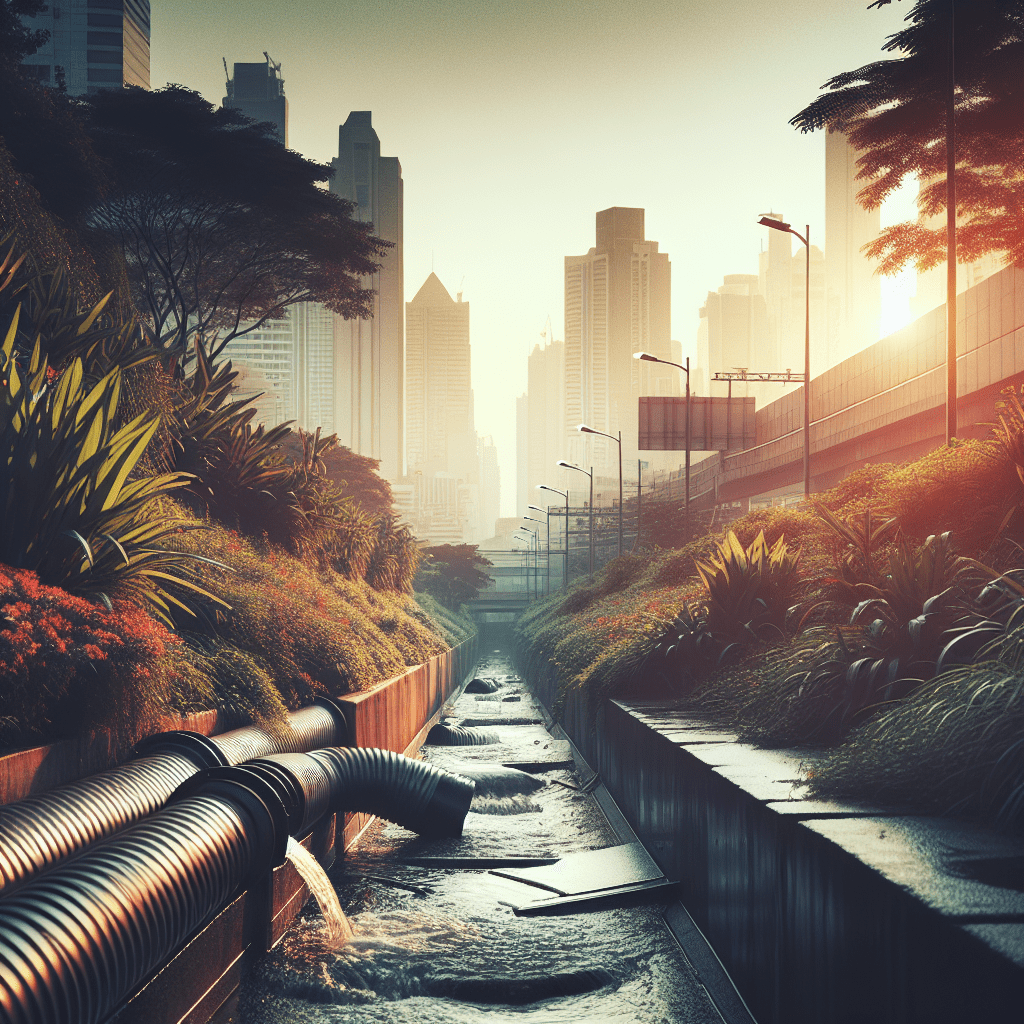Introduction To Trench Drains
If you’ve ever wondered where rainwater or other water in outdoor areas disappears to, you’d be surprised to know that trench drains do much of the work in many of these situations.
In this article, we’ll discuss the essential role of trench drains in managing water, how they help prevent erosion, contribute to safety, and where you can typically find them. We will explore their various components and cover the benefits of installing trench drains.
Visually, we can identify a trench drain by many factors which we are going to discuss while also addressing the various materials that construct a trench drain.
Still, it doesn’t stop there; when is it appropriate to use trench drains, and what are the disadvantages of trench drains?
All these questions will be answered and more – now let’s explore the world of trench drains!
Table of Contents
The Purpose of a Trench Drain
Understanding Trench Drains
A trench drain is a specific type of drainage system designed to remove surface water. It’s typically narrow, elongated, and covered by a grate. These drains are usually installed at ground level and play an important role in construction and landscaping.
Primary Functions
Trench drains serve several essential purposes in various environments:
- Water Management: They collect and channel water away from areas prone to flooding.
- Prevent Erosion: By efficiently controlling water flow, they help minimize soil erosion.
- Safety: Reducing water accumulation on pathways and driveways can prevent slip hazards.
Where Are Trench Drains Used?
You’ll find trench drains in multiple applications, both residential and commercial:
- Parking Lots: To manage runoff from large paved areas.
- Driveways: To keep water from pooling and damaging the surface.
- Industrial Sites: For handling water and other liquid waste.
Trench Drain Components
| Component | Description |
|---|---|
| Trench | The channel dug into the ground to capture water. |
| Grate | A cover placed over the trench to allow water in and keep debris out. |
| Catch Basin | A container at the end of the trench collecting and directing water to drain pipes. |
Benefits of Installing Trench Drains
Trench drains offer several advantages:
- Durability: Made from materials like concrete and metal, they can withstand heavy use.
- Efficiency: Quickly remove large volumes of water from surfaces.
- Versatility: Suitable for various settings, ensuring broad utility.
For more detailed information on trench drains, you can visit this Concrete Network page, which offers further insights into their uses and benefits.
The Visual Characteristics of a Trench Drain

Physical Appearance and Design
At first glance, a trench drain might seem like a simple groove in the ground. However, the design and physical attributes of these drainage features are intricate. Generally, trench drains are rectangular, ranging from a few inches to several feet wide, and are usually longitudinal in design, often spanning across the length of an area.
The trench drain’s visibility largely depends on the type of grate used. Some grates sit flush with the surface, making them harder to notice, especially when integrated into landscaping, paving or concrete. Others might be more prominent, with visually distinctive grate patterns, shapes or colors.
Common Materials Make Up a Trench Drain
Trench drains can be made from various materials, each with unique aesthetic and functional attributes:
- Concrete: Offers durability and strength. It’s also able to blend with concrete surroundings for a seamless look.
- Plastic/PVC: These drains are lightweight, affordable, and easy to install. However, their appearance might be more noticeable due to the material’s color variation from most surroundings.
- Metal (Steel or Iron): These tend to be more robust and durable. Depending on the surface finish, metallic trench drains might display a distinct, industrial aesthetic.
Trench Drain Grates
The grate is the visible part of the trench drain that sits on the surface. Generally, it’s made of metal, plastic or composite materials and features a variety of designs. Common patterns include transverse slots, longitudinal slots, or perforations. Grate design can influence both the performance and aesthetics of the trench drain, as they dictate the water intake efficiency and how the drain visually integrates with its environment.
Trench Drain in Different Environments
A trench drain’s appearance can change with its surroundings, majorly dictated by the environment’s necessities:
| Environment | Trench Drain Appearance |
|---|---|
| Residential Areas | Trench drains in homes might be smaller and integrate seamlessly with the landscaping or driveway. |
| Commercial Spaces | In commercial areas like parking lots or malls, drains are larger, more conspicuous, and often finished with heavy-duty grates. |
| Industrial Sites | These are typically very large, robust, and made from heavy-duty materials to handle extreme conditions. |
If you’d like to view various trench drain designs and installations, consider browsing the Stromtech website. Their gallery showcases a wide array of trench drain deployments in different settings.
When Should You Use a Trench Drain?
Need for Efficient Water Management
You should consider using a trench drain when dealing with areas prone to water pooling or flooding. These drainage systems are vital for managing runoff efficiently:
- Heavy Rainfall Areas: If you’re in a region that experiences substantial rainfall, a trench drain can prevent flooding and water damage.
- Flat Terrain: In locales where the terrain is flat and lacks natural drainage slopes, trench drains help redirect water flow efficiently.
Preventing Structural Damage
Using a trench drain can be essential in scenarios where water accumulation may endanger structural integrity:
- Basement Protection: If your property includes a basement, installing trench drains around the perimeter can prevent flooding and water seepage that might damage foundations.
- Commercial Buildings: Large structures such as malls or warehouses can suffer from extensive water damage without proper drainage systems.
Enhanced Safety
Trench drains are vital in ensuring the safety of various environments by mitigating hazards associated with water accumulation:
- Public Pathways: To avoid slip-and-fall accidents in pedestrian zones, particularly in public spaces like parks, sidewalks, and recreational areas.
- Sports Facilities: Sporting venues, especially fields and courts, require proper drainage to maintain playable conditions and prevent injuries.
Aesthetic and Functional Landscaping
In landscaping projects where aesthetics and functionality are important, trench drains can be integrated subtly or prominently depending on the design requirements:
- Gardens and Lawns: Keep your green spaces healthy by using trench drains to manage excess water that could lead to root rot or other plant diseases.
- Hardscapes: For patios, walkways, and pool decks, trench drains can be both a functional and aesthetic addition, ensuring water is efficiently removed and surfaces remain clean and dry.
Industrial and Commercial Uses
Trench drains serve a key role in various industrial and commercial settings due to their ability to handle large volumes of water and other liquids:
- Food Processing Plants: These facilities often require high hygiene standards, and trench drains help manage waste liquids effectively.
- Car Washes: Consider trench drains to manage the water used in washing vehicles, preventing water accumulation and ensuring efficient runoff.
Check out more examples and detailed applications of trench drains on the Concrete Network. They provide extensive resources and case studies on effective trench drain uses across different industries.
What Are the Disadvantages of Trench Drains?
High Initial Installation Costs
Although trench drains are effective for water management, their installation can be costly. The expenses include significant labor for excavation, materials, and sometimes specialized equipment.
- Excavation Costs: Digging a trench to the required depth and width can be labor-intensive and may require heavy machinery.
- Material Costs: High-quality materials like stainless steel or reinforced concrete can be expensive, particularly for larger projects.
- Specialized Labor: Proper installation often requires skilled labor to ensure that the drainage system functions correctly and meets local regulations.
Maintenance Requirements
Trench drains require regular maintenance to ensure they function effectively. Neglecting this can lead to clogs and other issues.
- Debris Accumulation: Leaves, dirt, and other debris can clog the trench and grate, necessitating frequent cleaning.
- Periodic Inspections: Regular inspections are vital to check for wear and tear, especially in high-traffic areas.
Potential for Clogging
Trench drains, although efficient, can be prone to clogging if not adequately maintained. This can compromise their functionality and cause water to pool in the area they are meant to drain.
- Blocked Grates: The grates can trap leaves, litter, and other debris, impeding water flow.
- Subsurface Clogs: Sediment and fine particles can settle in the trench and pipes, leading to blockages over time.
Structural Concerns
Improper installation or substandard materials can lead to several structural problems that may affect the efficiency and durability of trench drains.
- Shifting Ground: If the ground beneath the trench drain shifts, it can cause the drain to crack or misalign, impacting performance.
- Material Degradation: Certain materials like plastic may degrade over time, particularly in areas with harsh weather conditions or heavy loads.
Limited Aesthetic Appeal
Though trench drains are functional, their appearance may not always mesh well with every environment, potentially detracting from the overall aesthetic.
- Visible Grates: Even if designed to be low-profile, the grates can disrupt the visual harmony of beautifully landscaped areas or well-designed patios.
- Variability in Matching Materials: The materials used for trench drains may not always match the surrounding décor, especially in residential settings.
For more detailed insights into the drawbacks and maintenance of trench drains, you can visit this Concrete Network page. They offer comprehensive guides and case studies on trench drain systems.
In Conclusion
Trench drains are resilient, efficient, and versatile tools used for surface water management in several environments, both residential and commercial. They provide important benefits, such as preventing erosion, ensuring safety by reducing water accumulation, and preventing structural damage.
Trench drains’ key components include the trench, grate, and catch basin, all working together to capture, channel, and redirect water. However, their implementation can bring challenges such as high initial installation costs, maintenance requirements, potential for clogging, structural concerns, and the potential disruption of aesthetic harmony.
Nonetheless, with a well-thought-out placement and regular care, trench drains can effectively bolster water management in numerous settings.
Frequently Asked Questions – FAQs
What is a trench drain?
A trench drain is a specific type of drainage system designed to remove surface water. It’s often narrow, elongated, covered by a grate, and installed at ground level.
Why are trench drains important?
Trench drains help manage water, preventing erosion and flooding. They also enhance safety by reducing water accumulation on pathways and driveways, thereby preventing slip hazards.
What are the main components of a trench drain?
The three main components of a trench drain are the trench itself, the grate that covers it, and the catch basin at the end of the trench that collects and directs the water towards the drain pipes.
What are some drawbacks of trench drains?
Challenges associated with trench drains include high installation costs, regular maintenance requirements, a tendency to get clogged if not properly cared for, structural concerns due to improper installation or materials, and the potential disruption of aesthetic harmony in certain environments.
Where can I find more information about trench drains?
For more detailed information on trench drains, you can visit the Concrete Network page, which offers extensive resources and case studies on effective trench drain uses across varied industries.







Awesome thank you this is excellent information!